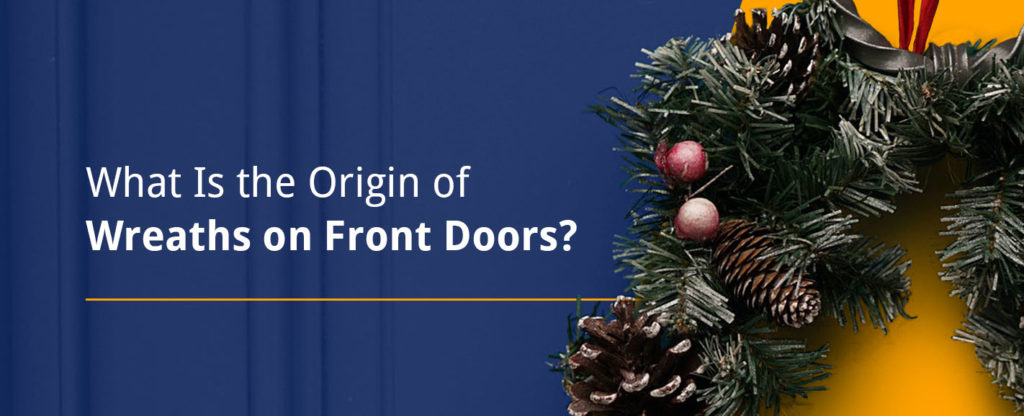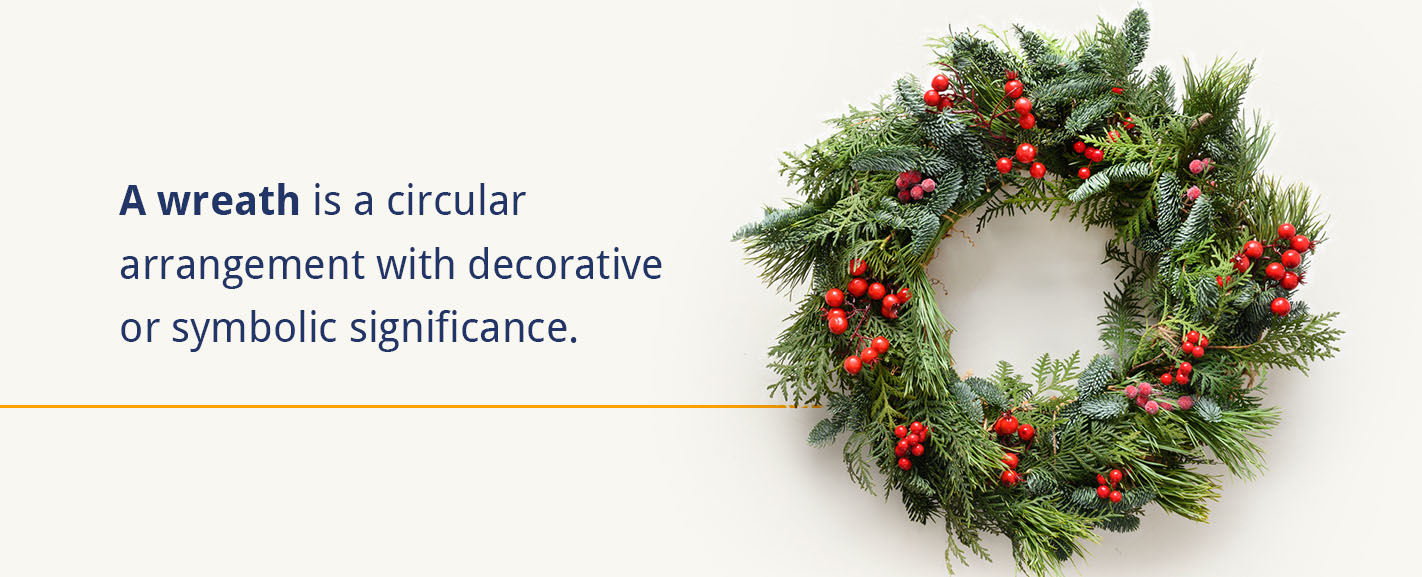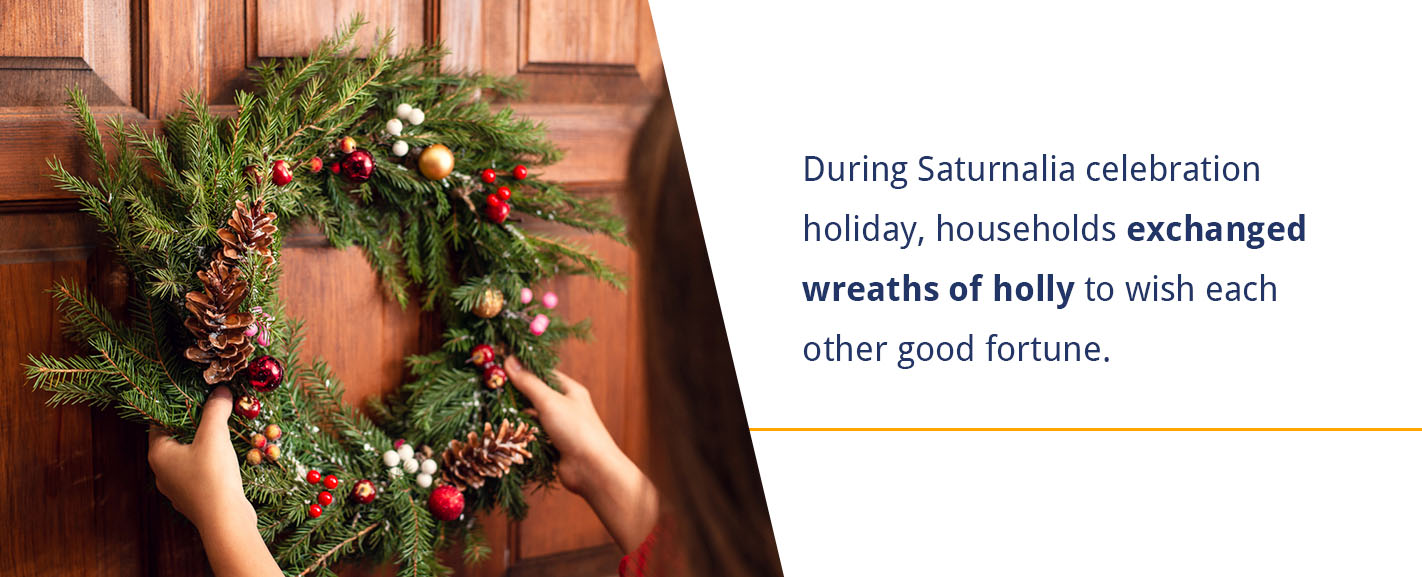What Is the Origin of Wreaths on Front Doors?
11/04/2021, 2:40 PM

Did you know when you hang a wreath on your door, you’re participating in a tradition over 2,800 years old? Ancient civilizations, such as Greece and Rome, used wreaths in celebrations and to adorn their rulers’ heads. The origin of hanging a wreath on the front door comes from various influences from around the world.
Discover the history of wreaths on doors and why we hang wreaths around the holidays.

What Are Wreaths?
A wreath is a circular arrangement with decorative or symbolic significance. It often consists of natural materials, such as flowers, stems and pinecones, but it’s also possible to craft wreaths from manufactured elements.
People display wreaths both inside and outside their homes. They can be hung on doors or walls or used as table centerpieces. There are also numerous occasions to decorate with wreaths. Some examples include seasonal changes, cultural or religious holidays, and festive celebrations such as Thanksgiving or Christmas.
Ancient Greece and Rome’s Laurel Wreath
Laurel wreaths gained popularity in ancient civilizations as markers of bravery, status and accomplishment. Various stories about their origins in Greek and Roman cultures exist.
The Story of Apollo and Daphne
One of the first known iterations of a laurel wreath appears in a story from ancient Greek mythology called Apollo and Daphne. According to the legend, the god Apollo, patron of sports and god of the sun, poetry, music, art, archery, and knowledge, ridiculed Eros, the god of love, for his smaller bow. In return, Eros shot Apollo with a golden arrow, causing him to fall deeply in love with Daphne, a river nymph. Eros shot Daphne with an arrow of lead to make her impervious to love.
Daphne had rejected many suitors in the past and applied the same approach when Apollo came to her. However, Apollo still pursued her. The two seemed forever trapped in a chase, Apollo pursuing the unwilling Daphne. One day, with the help of Eros, Apollo caught up to Daphne.
Faced with her impending capture by Apollo, Daphne despaired and begged her father, the river god, to help her gain freedom from him. She then transformed into a laurel tree. Apollo vowed to honor the laurel tree forever, and with his powers, he made the laurel tree evergreen. In most depictions of Apollo in art and sculpture, he wears or carries a laurel wreath. As a result, the wreath became a symbol of victory for the ancient Greeks.
The Ancient Olympic Games
The Olympic Games, in which most countries still participate, originated in ancient Greece. As a civilization that highly prized athletic achievements and sports, the Greeks hosted huge competitions in which only one victor was crowned — unlike the modern events that allow three winners to receive medals.
The Games began as a religious festival for Zeus, the father of all mythical Greek gods and goddesses. Held in Olympia, male athletes from all over the Greek world converged to participate in these games in honor of Zeus. History also tells us the ancient Greeks held another competition for Hera, the wife of Zeus. Young, unmarried girls were allowed to compete, and many historical accounts suggest these games are as old as the men’s games in Olympia.
While other athletic competitions produced prizes like bronze, shields and olive oil, the Pan-Hellenic Olympic Games offered only one prize — wreaths made of olive, laurel, pine or wild celery leaves.
The Roman Copycats
The use of wreaths in ancient Rome originates from two other civilizations. Firstly, the Etruscan rulers who occupied central Italy wore wreaths on their heads — until neighboring Roman forces conquered and assimilated their culture. Additionally, as great admirers of Greek culture, the Romans adopted laurel wreaths for their rulers and prominent warriors to designate victory in battle.
Roman emperors often wore laurel wreaths to designate their victories, status and power. Statues, mosaics and even coins with the emperor’s faces usually included a laurel wreath crown.

Saturnalia Celebration Wreath — Ancient Rome
The ancient festival of Saturnalia celebrated the Roman agricultural god Saturn. Falling near the winter solstice in mid-December, Saturnalia is known as a holiday for role reversals and festivities. Usually, Romans valued order and discipline — showcased by their impressive military history and judicial system. That changed during the festival of Saturnalia.
Schools, courts and all normal business operations were halted so everyone could enjoy the festivities. Even servants and enslaved people received a reprieve from their work and enjoyed certain benefits of full citizens. Activities like drinking, gambling, feasts and games abounded during the festival, making it famous as one of the merriest Roman holidays.
The history of Saturnalia as a festival of role reversals originates in the tradition of crowning a mock king for the festival. Each household would choose a lower-class member, usually a servant or an enslaved person, to “lead” the household for the week of the festival. Their role was to play jokes and create light-hearted mischief, and they could wear wild clothing and insult guests. Enslaved people and servants were even allowed to show a certain measure of banter and criticism against their masters during Saturnalia.
Most historians agree that the role-reversal aspect of the festival played an important part in releasing social tension that built up throughout the year. Roman society had strict rules of governance and hierarchies, so granting lower-class members of society larger freedoms during the celebration helped release some of the built-up pressure.
Another essential aspect of the holiday was the adornments. During this jolly holiday, households exchanged wreaths of holly to wish each other good fortune.
Today, many of our Christmas traditions derive from Saturnalia traditions, including hanging wreaths on our doors and gift-giving. The early Christians also settled on this time of mid-winter festivities to celebrate the birth of Jesus.
Christian Religious Symbolism of the Wreath
While the Saturnalia wreath was a simple decoration for the pagan Romans, early Christianity developed a complex and meaningful association with wreaths. They came to serve as direct reminders of God’s love and sacrifice and feature prominently in the season of Advent.
The Crucifixion
Primarily, wreaths gained an association with Christianity due to biblical accounts of the crucifixion, which explain how Roman soldiers fastened a crown of thorns for Jesus to wear as he walked to the crucifixion site. The crown of thorns stood as a mocking testimony of the charges placed against Jesus — specifically, charges of treason for claiming to be King of the Jews.
The evergreen wreath with red berries traditionally hung during winter has deep symbolism within Christianity. The circular shape represents the Christian God’s everlasting love and the circle of life. The evergreen leaves symbolize eternal life, and the red berries serve as reminders of Jesus’ blood.
Wreaths are hung during Christmas time rather than Holy Week and Easter — the celebration of Jesus’ death in the Christian calendar — as the birth of Jesus serves as a reminder to all Christians of God’s sacrifice and love. During winter, the evergreen leaves and berries symbolize continuous life, even through the cold winter months.
Advent Wreaths
The tradition of Advent originates in the idea of preparation. The word for Advent comes from a Latin word meaning “coming,” so it’s meant to signify the impending birth of Jesus at Christmas. The four-week celebration allows the faithful to prepare their minds and hearts to welcome Jesus into their lives.
The traditional Advent wreath contains various evergreens with different symbolism, such as:
- Laurel: The laurel in Advent wreaths symbolizes victory over death and persecution.
- Pine: The pine branches or cones symbolize immortality, both in the everlasting love of God and Jesus’ death and resurrection.
- Holly: The prickly leaves of the holly plant symbolize the crown of thorns worn by Jesus at his crucifixion, while the plant’s red berries represent the blood he shed on the cross. These symbols further indicate immortality.
- Cedar: Cedar stands as a symbol of healing and strength. It reminds the faithful to remain strong and strengthen their faith in preparation for the birth of Jesus.
Advent wreaths are also characterized by candles. Three candles are purple — symbolizing prayer and penance — and one is pink to represent joy. In weeks one, two and four, the purple candles are lit, and in the third week, the pink candle is lit to represent the halfway point of celebrating Christmas.
Why We Have Evergreen Wreaths
Evergreen plants maintain their leaves from their growth into the new season. There are two types of evergreen leaves — needle-leaved and broad-leaved. These branches are great for decorating in the winter because they are long-lasting and stay fresh. Some evergreen trees, such as firs, spruce and pine, have a beautiful fragrance — so much so that you can often find candles and potpourri mimicking the scent of common winter evergreens.
The evergreen plant symbolizes perseverance and the continuation of life in nature. Its leaves stay green even while many other plants’ leaves wither and fall off as the weather gets colder. A few evergreens feature prominently in wreaths, but access to these plants in the wild tends to change depending on the climate.
Popular Evergreen Plants
Some of the most popular evergreen plants include:
- Holly
- Boxwood
- Pine
- Magnolia
- Hemlock
- Fir
- Cyprus
- Mountain laurel
- Yew
- Juniper
- Cedar
- English ivy
Depending on your region, you may be able to find some of these plants just outside your window. Having evergreen plants in your landscaping is an attractive feature as they add a touch of green even in the winter months. They also tend to be hardy plants and can survive in various temperatures and climates.
During the holiday season, many organizations will offer special live evergreen wreaths you can order for delivery right to your door. Or, just take a walk outside and grab any fallen evergreen branches and leaves in good condition to create your wreath.
Wreaths Today Are Used for Christmas and Other Occasions
Wreaths are a feature in a variety of holidays and occasions now. For many, wreaths don’t hold any special religious significance — rather, they’re a popular and simple decoration to liven up your door around the holidays.
The materials for wreaths often vary, but many holiday wreaths, which are the most popular, feature evergreens such as pines, firs, holly and boxwood. A mixture of needle-leaved and broad-leaved evergreens adds an attractive texture and varying tones to the wreath. Red berries, poinsettia flowers, pine cones and ribbons are other common adornments for holiday wreaths.
Fall Wreaths
Wreaths for front doors are growing in popularity outside the festive season. Nowadays, wreaths populate home decoration stores and craft fairs in all seasons. Autumn wreaths are some of the most popular, featuring warm tones like reds, yellows and oranges to mirror the changing colors of the leaves. Additions like dried corn cobs, acorns, wheat and small gourds also generate festive fall feelings and celebrate the harvest.
Spring Wreaths
Following the season, spring wreaths are colorful and often feature soft pastel hues such as pinks, purples, yellows and creams. Popular springtime wreath components include lavender, rose, peonies, tulips and sunflowers, with leafy green accompaniments. Because Easter also falls in spring, some wreaths feature painted or colored eggs and other symbols of the holiday, such as bunnies, butterflies and ducklings.
Other Holiday Wreaths
Doubtlessly following the popularity of Christmas and seasonal wreaths, you can find wreaths celebrating other holidays such as Halloween, Fourth of July, Thanksgiving, St. Patrick’s Day and Valentine’s Day. Many people enjoy adorning their homes with wreaths as a symbol of the coming festivities or as part of their part decoration.
A popular Scandinavian holiday, Midsummer, celebrates the beginning of summer and rejoices in the coming harvest. Those who participate in the festivities wear flower crowns or wreaths made of flowers on their heads to symbolize rebirth and fertility.
Funerals and Weddings
Wreaths also have significance at personal events such as weddings and funerals. Some cultures include wreaths made of flowers and leaves in wedding ceremonies, adorning the bride and groom with these to celebrate fertility. Today, they’re a common fashion adornment on or in place of veils.
Flower wreaths at funerals represent the circle of life and originate in ancient Egyptian, Greek and early Christian traditions.
Arts and Crafts
Wreath-making has expanded into an industry, but many people still make their own. The arts and crafts movement has grown in popularity in recent decades, which actually brings wreath-making back to its roots. Originally, wreaths were a way to use the leftover clippings from Christmas trees. Today, many crafters get extra creative with their wreath-making, adding everything from lights to fake snow to enhance the festivity of the wreath.
Modern Innovations in Wreath-Making
Even though the tradition of making wreaths has existed for millennia, it has evolved to reflect modern trends. Here’s a detailed overview of three innovations in wreath making.
Using Sustainable Materials
Younger generations have become more environmentally conscious, with Generation Z leading the movement. As such, there’s been a greater effort to use greener alternatives in wreaths. Some options include:
- Natural elements: Instead of using manufactured items, many people decorate their wreaths with dried flowers, twigs and wild grasses. By using natural materials, there’s less need for processing and shipping.
- Upcycled materials: Another innovative way to minimize your carbon footprint is repurposing old materials in wreaths. For example, you could create a fabric wreath using old T-shirts or scarves.
- Biodegradable options: There are now many biodegradable dyes, paints and adhesives on the market. Using these options helps wreaths break down over time when they’re no longer in use.
Personalized Crafts
Instead of hanging a generic wreath, many homeowners create one that matches their distinctive style. From using their favorite flowers to colors that match their interior, there are multiple ways to make a wreath truly unique. Adding a monogram or family name in wooden letters or embroidered ribbon is a further way to personalize a wreath.
Technology
Technology has impacted all areas of our lives, even wreath making. In particular, 3D printers have enabled crafters to print intricate designs to enhance their displays. LED lights with smart technology further add to the overall appeal of wreaths. Homeowners can simply control their functioning with a handy app on their phones.

